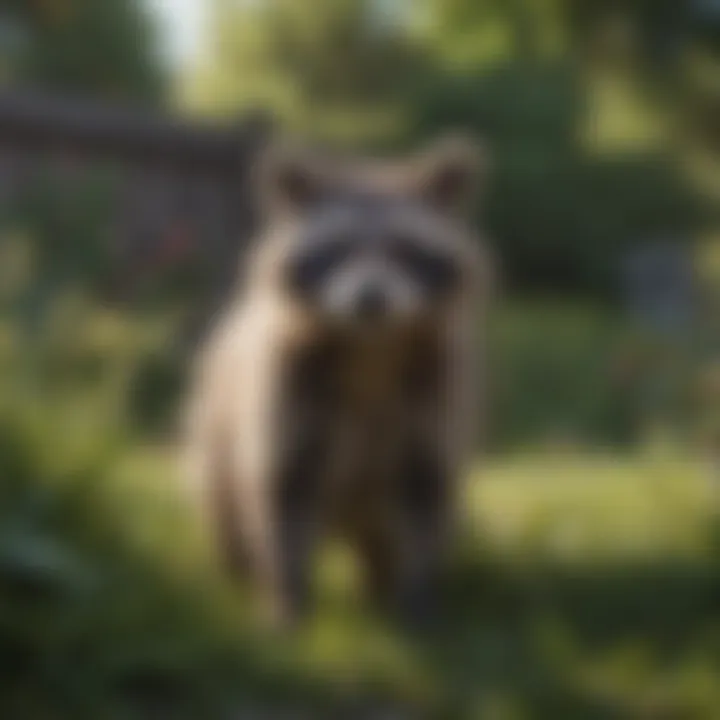Effective Strategies for Raccoon Intrusions


Intro
Raccoons, with their clever paws and masked faces, often intrude on human properties, causing many disturbances. Understanding these creatures is essential for homeowners, especially for those who face consistent challenges posed by raccoon intrusions. By grasping their behaviors and attraction points, one can implement effective preventive strategies to keep them at bay. This article will delve into the various aspects of managing raccoon intrusions, focusing initially on preventive pest control strategies.
Preventive Pest Control Strategies
Preventive measures are pivotal in managing raccoon intrusions. A proactive approach can save time and resources that may be expended after an infestation occurs. Here are several strategies designed to fortify your property against these persistent animals.
House Exterior Protection
Tips for sealing cracks
Raccoons can squeeze through surprisingly small openings. Inspect the exterior of your house for any gaps or cracks. Pay special attention to areas around windows, doors, and vents. Use a weather-resistant sealant to cover noticeable gaps. This acts as a barrier.
Clearing debris
Remove items like fallen leaves, branches, or garbage near your home. Such debris can become a den for raccoons and attract them to your property. A clean exterior limits hiding spots for pests.
Preventing pests from entering
Keep exterior doors and windows closed or securely screened. Install latches on doors. Check that your chimney is capped, preventing wildlife from taking refuge inside. This comprehensive approach limits access points.
Yard Maintenance
Essential yard care routines
Regularly maintain your yard to discourage raccoons from frequenting your property. Mow the lawn frequently and trim back overgrown shrubs. This deterrent makes your yard less appealing for them.
Methods for keeping yard pest-free
Consider planting native, pest-repelling plants, which can discourage raccoons. Some examples include marigolds and mint. Incorporating these plants can create a natural barrier against raccoons looking for food.
Indoor Cleanliness
Expert cleaning tips and techniques
A clean indoor environment is crucial. Regularly vacuum and dust to remove crumbs and potential food sources. Pay attention to areas behind appliances where food particles can accumulate, serving as bait for intruders.
Maintaining a pest-resistant indoor environment
Store food in sealed containers and avoid leaving dishes in the sink. This practice minimizes alluring scents that might attract raccoons into your space.
Garbage Disposal
Efficient waste disposal methods
Garbage cans should be tightly sealed. Consider using raccoon-proof containers to prevent raccoons from accessing trash. Ensure that these containers are stored inside a garage or shed, if possible.
Importance of proper garbage disposal
Proper disposal of waste reduces not only raccoon intrusions but also limits the attraction of other pests. Raccoons commonly forage for food, so addressing garbage management plays a significant role.
Other Pest Prevention Strategies
Innovative ways to safeguard your home
Keep pet food inside and avoid leaving it outside overnight. Motion-activated lights or sprinklers can also deter nocturnal creatures. These lighting devices startle them, making your yard less inviting. An evaluation of your home and outdoor spaces will provide insights into additional deterrents that can be utilized.
"Preventing raccoon intrusions requires a sustainable approach that encompasses both home protection and environmental management."
Implementing these preventive pest control strategies lays a solid foundation for managing potential raccoon intrusions. With a focus on house exterior protection, yard maintenance, indoor cleanliness, and proper garbage disposal, homeowners can significantly enhance their defenses against these determined animals.
Prelims to Raccoon Behavior
Understanding raccoon behavior is critical for homeowners and property managers facing intrusions from these adaptable creatures. Raccoons are intelligent and resourceful animals, which makes managing their presence more complex. By recognizing their biology, social structures, and habits, individuals can make informed decisions to deter them effectively. This section aims to lay the groundwork necessary for a comprehensive understanding of raccoon behavior, ensuring effective management strategies are deployed.
Biology of Raccoons
Raccoons belong to the Procyonidae family and are native to North America. Their distinctive features include a masked face and ringed tail. Adult raccoons weigh between 10 to 30 pounds, depending on their habitat and food sources. They possess a keen sense of touch and are adept at manipulating objects with their front paws. This dexterity is a significant factor in their ability to access food and shelter in urban environments.
Their fur is typically grayish-brown, providing camouflage in wooded areas. Raccoons are nocturnal, primarily active during the night, which reduces their likelihood of human encounters. Their adaptable nature drives them to inhabit diverse environments, from rural forests to urban backyards.
Social Structure and Habitat


Raccoons are generally solitary animals, though they may form loose groups in favorable conditions. Female raccoons typically have a home range that includes den sites for raising their young. Mating occurs in late winter or early spring, resulting in litters of two to seven offspring, which the mother raises alone.
Their habitats are chosen based on food availability and shelter options. Urban areas often provide ample refuse, making them attractive to raccoons. Dens are usually found in hollow trees, attics, or abandoned structures. Understanding how these animals organize socially and where they prefer to live can help property owners identify and address potential issues.
Feeding Habits and Preferences
Raccoons are opportunistic omnivores. In the wild, their diet includes fruits, nuts, seeds, insects, and small rodents. In urban settings, they are notorious for raiding garbage cans and dumpsters. Their penchant for scavenging often leads them to human habitats where they seek easy access to high-calorie foods.
Raccoons use their sensitive paws to explore food sources. Their primary feeding times align with nighttime activity. This behavior emphasizes the need for homeowners to be vigilant, especially at dusk or dawn when raccoons are most likely to appear.
By understanding these aspects of raccoon behavior, effective management strategies become more apparent. It is essential for homeowners to recognize the signs of raccoon presence to take action before infestations occur.
Recognizing Signs of Raccoon Presence
Recognizing the signs of raccoon presence is critical for homeowners and property managers. Early detection allows for prompt action to reduce potential damage and deter these creatures from establishing a stronghold in residential areas. Raccoons are nocturnal animals; therefore, their activities are often hidden during daylight hours. Understanding their signs helps identify intrusions before they escalate into larger problems. Moreover, being aware of specific indicators aids in implementing appropriate measures for deterrence effectively.
Physical Indications of Raccoons
Physical signs that raccoons have been in the area include their paw prints, feces, and distinctive tracks.
- Tracks and Paw Prints: Raccoon paw prints are easily recognizable due to their size, typically spanning about 3 to 5 inches. They exhibit five toes on both the front and back feet, with the front paws being more rounded. Identifying these prints can confirm raccoon activity, especially near trash or gardens.
- Feces: Raccoon feces is often cylindrical and about one to two inches in length. The feces may contain indigestible materials like seeds and fur, giving it a unique appearance. Observing feces can indicate nearby feeding and nesting areas.
- Digs and Disturbances: Raccoons tend to dig through gardens or flower beds in search of food. If you notice overturned soil or disturbed mulch, this could be a sign of their nocturnal foraging habits.
Important Note: Regularly inspecting your property can help catch signs early. This could save you from more serious intrusions later on.
Behavioral Cues to Observe
Apart from physical signs, behavioral cues are essential for determining raccoon presence.
- Nocturnal Activity: Observing raccoons during the early morning or late evening can indicate their presence. If you notice disturbances in garbage or odd sounds in the night, this could suggest raccoon activity.
- Sighting of Multiple Individuals: Raccoons are social animals. If you see one, there may be more nearby. Their social nature can escalate problems quickly, so it is wise to act if multiple animals are observed.
- Unusual Sounds: Listen for noises that could indicate raccoons. These creatures may make chattering noises, growls, or even screams when feeling threatened. Unfamiliar sounds at night may suggest their presence.
Being able to recognize these signs will put homeowners in a proactive position to handle potential raccoon intrusions effectively. Regular observation and environmental monitoring are crucial components of managing raccoon-related issues.
Assessing Attractants on Your Property
Assessing attractants on your property is vital in managing raccoon intrusions effectively. Raccoons are opportunistic feeders, which means they are often drawn to a variety of food sources and potential shelter sites. Understanding what entices them is the first step toward proactive management. By identifying and eliminating these attractants, homeowners can reduce the likelihood of raccoons considering their properties as a suitable habitat.
Recognizing these attractants allows property owners to take informed actions that not only enhance their immediate environment but also contribute to a broader strategy for wildlife management. Discerning these factors minimizes contact with wildlife, promoting a safer living space. Moreover, this approach aligns with humane practices, focusing on prevention rather than reactive measures.
Food Sources that Entice Raccoons
Raccoons’ natural diet consists of fruits, nuts, insects, and small animals. However, in suburban areas, they often seek food from human sources. Here are common food sources that raccoons may find attractive:
- Unsecured garbage: Open trash cans create easy access for raccoons. They can easily tip over bins in search of food.
- Pet food: Leaving pet food outdoors can entice raccoons. This is a common mistake many homeowners make unknowingly.
- Bird feeders: While birds are the intended beneficiaries, fallen seeds can attract raccoons into your yard.
- Dog waste: Surprisingly, raccoons sometimes consume dog feces. It can create a steady, if unintentional, food source.
- Compost piles: Organic matter, especially food scraps, can easily attract raccoons when not managed properly.
To diminish these food sources, homeowners should secure garbage bins with tight-fitting lids, maintain clean outdoor areas, and avoid feeding pets outside.
Potential Shelter Sites
In addition to food, raccoons seek shelter to nest and rest. Various locations around the property can provide ample opportunities for raccoons to settle. Here are some common potential shelter sites:
- Sheds and garages: Unused spaces may allow raccoons to enter unnoticed. Cleaning and monitoring these areas are advisable.
- Attics and vents: Raccoons are skilled climbers and may find their way into attics through vents or unsecured roof entries.
- Basements and crawlspaces: These dark, undisturbed areas provide suitable shelter. Proper sealing of entry points is crucial.
- Woodpiles and debris: Raccoons can find security in piles of wood, leaves, or trash accumulated in a yard.
- Burrows: If your property is near woodlands or parks, raccoons may dig burrows for hiding.
Prevention against these shelter sources requires diligence in maintaining property cleanliness and regularly checking for potential entry points.
Developing a Raccoon Deterrence Plan
Creating a comprehensive raccoon deterrence plan is essential. It addresses the necessity of understanding raccoon habits. A strong plan reduces the chance of attracting raccoons to residential areas. Effective strategies act as barriers that discourage these animals from approaching your property. This approach not only protects your home but also promotes a sense of safety for you and your family.
Removing Food Sources
The first step in any raccoon deterrence plan is to remove food sources. Raccoons are opportunists, often seeking easy access to calories. If they find a reliable food supply, they are likely to return. Common sources that attract raccoons include pet food left outdoors, fallen fruits from trees, and unsecured bird feeders.
You should consider the following strategies:
- Feed pets indoors: Avoid leaving food out at night, as this attracts raccoons.
- Clean up fallen fruits: Regularly pick up any fruits that have fallen from trees. This reduces a potential attractant.
- Secure compost bins: Ensure that compost bins are kept closed and labeled as raccoons can pick them apart to find food.
By eliminating easy food access, you can significantly reduce the likelihood of a raccoon intrusion.
Securing Garbage and Compost
Securing all trash and compost is crucial in your deterrence strategy. Raccoons are notorious for rummaging through garbage bins in search of scraps. Improperly secured trash can serve as a buffet for them. It’s important to invest in solid solutions that prevent access.
Here are some tips:


- Use raccoon-proof garbage containers: Invest in bins with secure lids that raccoons cannot open easily.
- Store containers in a garage or shed: If possible, store trash cans inside until the pickup day. This cuts off their access completely.
- Opt for sturdy compost solutions: Use compost bins that raccoons cannot access. Look for options with locking mechanisms.
By prioritizing waste management, you can greatly deter raccoons from visiting your property.
Utilizing Fencing Solutions
Fencing can be an effective way to keep raccoons away from your yard. However, not all fences are created equal. Raccoons are capable climbers and diggers, so your fence must be designed to address their strengths.
Consider the following fencing strategies:
- Choose high fences: Install fences that are at least four to six feet high. Adding an overhang can make it harder for raccoons to climb over.
- Bury the fence: Digging the bottom of the fence at least a foot underground can prevent raccoons from burrowing underneath.
- Add a deterrent design: A fence with barbed wire at the top or angled outward can deter climbing.
Appropriate fencing can provide a substantial barrier against raccoon intrusions.
Effective deterrence requires a multi-faceted approach. By considering food sources, securing waste, and employing fencing, homeowners can significantly reduce raccoon activities.
Implementing Sounds and Lights as Deterrents
Implementing sounds and lights as deterrents is a crucial aspect of managing raccoon intrusions. These strategies aim to create an uncomfortable environment for raccoons, making it less appealing for them to invade your property. The use of auditory and visual deterrents can disrupt their behavior and ultimately lead them to seek shelter elsewhere.
Auditory Deterrents
Auditory deterrents exploit the sensitive hearing of raccoons. Understanding how raccoons respond to sounds can enhance your strategy for keeping them away. Here are some effective auditory tactics:
- Noise-Making Devices: Devices such as motion-activated sound emitters can be effective. When a raccoon approaches, the device generates loud noises, startling the animal.
- Traditional Noisemakers: Items like wind chimes or even bells can create a continuous source of noise, which may deter raccoons from lingering in the area.
- Recorded Sounds: Some homeowners have found success using recorded animal distress calls or predator sounds. Raccoons, being prey for certain larger animals, may vacate an area where they feel threatened by such noises.
While these auditory methods can be effective, it is also important to consider their potential impact on other wildlife and pets. Ensure that the sounds used do not create undue stress for non-target animals.
Lighting Solutions
Lighting serves as another powerful tool in the raccoon deterrence arsenal. Raccoons are primarily nocturnal, preferring to navigate in low-light conditions, so lighting can disrupt their patterns. Here are several approaches to consider:
- Motion-Sensor Lights: Installing motion-activated lights can startle raccoons and discourage them from returning. Bright, sudden illumination forces them to flee the area quickly.
- Flashing Lights: Some homeowners have effectively used flashing lights at night. The unpredictability of the light can be disorienting for raccoons, making them less likely to approach.
- Strategic Placement of Lights: Position lights near entry points or areas where raccoons are known to forage. This strategy can create a barrier of illumination, making it difficult for them to navigate.
Using sounds and lights as deterrents requires ongoing maintenance to remain effective. Check devices regularly to ensure they function properly and replace batteries when needed.
Consider combining auditory and lighting solutions for a synergistic effect. This multi-faceted approach can enhance the deterrent experience and lead to a raccoon-free property.
In summary, understanding the behaviors of raccoons and their aversion to noise and light can guide your deterrence strategies. Implementing these solutions not only helps protect your property but also contributes to a broader effort of coexistence with urban wildlife.
Using Chemical Repellents
Using chemical repellents can be a valuable aspect of managing raccoon intrusions. These products can help discourage raccoons from invading your space. Understanding the various types of chemical deterrents can lead to more effective strategies for protecting your property. It is essential to recognize that while these deterrents can help, they should be part of a broader approach to wildlife management.
Raccoons are adaptable creatures. They often become accustomed to their environments and may ignore physical barriers. Therefore, utilizing chemical repellents can provide an additional layer of defense. These products work by creating undesirable scents or tastes, leading raccoons to avoid the treated areas. It's vital to choose repellents that are safe for both humans and pets, ensuring minimal side effects on the local ecosystem.
Types of Chemical Deterrents
There are several types of chemical deterrents available on the market, each with unique properties and methods of operation:
- Granular Repellents: These are often made from natural ingredients and can be spread around a property. They emit strong odors that raccoons find unappealing.
- Spray Repellents: These can be applied directly to surfaces where raccoons might trespass. Many sprays contain substances derived from spicy ingredients which create an unpleasant experience for the animals.
- Scent-Based Repellents: Designed to mimic predator scents, these agents can discourage raccoons from approaching specific areas. Raccoons, being instinctively cautious, may avoid places that smell like potential threats.
It's important to research products to find the best options suited to your specific needs. Environmental factors such as weather may affect the durability of these repellents, making regular application necessary in some cases.
Application Methods and Precautions
When applying chemical repellents, following best practices is crucial to ensure effectiveness and safety. Here are some guidelines to consider:
- Read Instructions Carefully: Prior to using any product, always read the manufacturer's guidance. Understand the application process, optimal timing, and recommended quantities.
- Choose the Right Environment: Chemical repellents work best when applied in areas where raccoons are known to frequent. This can include garbage bins, gardens, or other potential attractants.
- Wear Protective Gear: It is wise to wear gloves and a mask while applying repellents. Even natural products may cause allergic reactions or irritation in sensitive individuals.
- Test a Small Area: Before applying the product to a larger section, use it on a small area to check for any unintended consequences. Monitor the area for any negative reactions from nearby plants or pets.
- Reapply Regularly: Chemical deterrents can be washed away by rain or may diminish over time. Schedule routine reapplication to maintain effectiveness.
- Monitor for Raccoon Activity: After application, keep an eye on the treated spots for any signs of raccoon presence. If issues persist, you may need to explore additional strategies alongside repellents.
By understanding and applying chemical repellents correctly, homeowners can create a less inviting environment for raccoons, significantly reducing the nuisance they cause.
When Professional Help Is Necessary
Raccoon intrusions can quickly escalate from a minor nuisance to a significant problem for homeowners. It is crucial to recognize when the situation requires professional intervention. Many individuals may feel confident in managing smaller raccoon encounters alone. However, understanding the need for expert assistance becomes evident when infestations reach a certain level of severity.
Identifying Severe Infestations
First, it is important to identify the signs of a severe raccoon infestation. Common indicators include:
- Consistent noise: This may manifest as scratching or scurrying sounds, particularly at night, when raccoons are most active.
- Increased waste: A significant accumulation of feces or scattered food remnants around your property may signal that raccoons are regularly frequenting your space.
- Damage to property: If you notice signs of attempts to enter attics or basements, such as torn insulation or chewed materials, this indicates that raccoons may be making nests or searching for food.
In these cases, attempting to manage the situation independently can lead to further issues. Raccoons are known carriers of diseases such as rabies, and improper handling can pose serious health risks to humans and pets.


Choosing the Right Wildlife Control Expert
Once it is clear that professional help is necessary, choosing the right wildlife control expert becomes essential. Here are some factors to consider:
- Licensing and credentials: Verify that the expert carries the proper licenses and follows local regulations regarding wildlife control.
- Experience with raccoons: Look for professionals who specialize in raccoon management, as their expertise will ensure effective strategies tailored to these animals.
- Humane methods: It is important to ensure that the chosen expert employs humane practices. Avoid any services that promote inhumane traps or extermination methods. Instead, they should prioritize relocation and deterrence.
- Customer reviews: Seeking feedback from previous clients can provide insight into the overall effectiveness and reliability of the wildlife control service.
"Effective wildlife management should prioritize coexistence with nature while ensuring human safety and property protection."
In summary, while some raccoon issues can be resolved independently, recognizing severe infestations requires caution. Opting for a qualified wildlife control expert can save you time, stress, and potential health risks.
Legal and Ethical Considerations
Addressing raccoon intrusions involves not just practical steps but also a strong understanding of legal and ethical aspects. These considerations are crucial for homeowners and property managers who want to navigate the complex landscape of wildlife control responsibly. Firstly, local regulations can dictate what methods are permissible for managing wildlife. Ignoring these laws can lead to severe penalties and further complications. Understanding the legal framework is essential for ensuring that actions taken are compliant and do not infringe upon wildlife protection laws.
Furthermore, ethical considerations merit careful attention. Many people advocate for humane methods of dealing with raccoon problems. This not only aligns with societal values of compassion towards animals but also ensures that broader ecological balance is maintained. Effective human-wildlife coexistence relies on recognizing that raccoons are part of our ecosystem. Therefore, taking humane approaches can foster a sense of responsibility towards these creatures and ultimately lead to more sustainable interactions.
In summary, awareness of legal and ethical considerations enhances the effectiveness of raccoon management strategies. This understanding preserves local wildlife populations, minimizes potential legal disputes and promotes ethical community values.
Understanding Local Regulations
Local wildlife regulations often vary by region. These regulations are typically designed to protect both the public and the animals involved. One key element to understand is whether trapping and relocating raccoons is allowed. In many areas, particular laws might restrict relocation practices, requiring individuals to seek out licensed professionals. Homeowners need to familiarize themselves with these rules. Many local governments provide clear guidelines online, making it simpler to find pertinent information.
"Wildlife management is not just about removing animals; it's about understanding their role and importance in the ecosystem."
In addition to state and national regulations, different municipalities may impose their own restrictions. Researching your particular city or county regulations can help prevent unintentional violations. Engaging with community resources, like local wildlife control services or forums, often proves beneficial as well. Connecting on platforms like reddit.com can also provide added insights into others' experiences and local laws.
Humane Approaches to Wildlife Control
Humane approaches to controlling raccoons focus on deterrence rather than harm. Firstly, exclusion methods should be prioritized. This involves securing homes and properties by blocking access to entry points. Measures like closing chimneys, repairing holes, and installing mesh screens can prevent raccoons from becoming intruders.
Utilizing repellents can also play a part in humane control. Natural substances, such as cayenne pepper or diluted vinegar, can deter raccoons without causing them harm. Planting certain herbs that raccoons tend to avoid, like lavender or mint, can also be useful.
Finally, education within the community is vital. Working together with neighbors on shared wildlife management strategies can lead to improved successes in preventing raccoon intrusions. Hosting an event or joining a wildlife management group can generate support and effective solutions that respect both animals and human interests.
By integrating humane tactics into planning, individuals can address raccoon issues responsibly and ethically.
Long-Term Prevention Strategies
Long-term prevention of raccoon intrusions is essential for homeowners seeking to maintain a safe and peaceful living environment. By establishing proactive measures, not only can one reduce the chances of future infestations, but also contribute to a broader ecological balance. Understanding the behaviors of raccoons and their interaction with the ecosystem can inform effective strategies that are sustainable and humane.
Community Engagement for Wildlife Management
Community involvement plays a crucial role in raccoon management. When neighbors collectively strive to address the challenges posed by raccoons, results can be more impactful. Here are key aspects of community engagement:
- Public Awareness Campaigns: Local governments or community organizations can promote educational programs that inform residents about raccoon behaviors, attractants, and preventive measures. Workshops can be organized to demonstrate proper garbage disposal and property securing methods.
- Collaborative Clean-Up Efforts: Organizing neighborhood clean-up days can significantly reduce attractants. When everyone participates, oversights that lead to raccoon presence can be minimized, such as unsecured trash and leftover pet food.
- Reporting System: Creating a simple reporting system for raccoon sightings or signs of intrusion can foster quick responses. This proactive approach allows for better resource allocation in addressing raccoon management issues.
- Information Sharing: Residents can benefit from sharing ideas and observed trends regarding raccoon presence and behaviors. Through platforms like Facebook or Reddit, communities can create groups dedicated to wildlife management, providing a space for discussion and solutions.
Continual Monitoring of Property
Ongoing vigilance is vital in preventing raccoon intrusions. Regular monitoring can help catch potential issues before they escalate. Here’s how to implement effective monitoring:
- Scheduled Property Inspections: Homeowners should schedule regular walkthroughs of their property to check for potential raccoon attractants. Look for unsecured garbage, pet food, and gaps in fencing. Conducting these inspections quarterly can be a practical approach.
- Setting Up Cameras: Installing motion-sensitive cameras around property lines can offer valuable insights into raccoon activity. This data can help identify peak times of intrusion and specific problem areas on the property.
- Taking Notes: Keeping a log of raccoon sightings and behaviors will help in understanding patterns. By documenting the situations in which raccoons appear, residents can adapt their strategies accordingly.
- Neighborhood Alerts: Establishing a quick communication channel among neighbors can enhance monitoring efforts. If one person notices a raccoon, it can alert others to be on watch, thus fostering a community-wide awareness.
"The key to effective raccoon management lies in proactive community strategies and continuous property awareness."
By fostering community collaboration and maintaining ongoing monitoring efforts, homeowners can significantly mitigate the risks and challenges brought forth by raccoon intrusions. This commitment to long-term strategies not only safeguards one’s home but also supports responsible wildlife management practices.
Ending and Future Considerations
In reflecting on the management of raccoon intrusions, it is crucial to understand the interconnectedness of diverse strategies and their long-term implications. Developing a thoughtful approach will not only aid in mitigating raccoon nuisances but also promote a balanced coexistence with local wildlife. This balance is vital for protecting properties and ensuring respect for nature.
One key element discussed throughout this article is the comprehensive understanding of raccoon behavior and environmental factors that attract them. Recognizing these patterns allows homeowners and property managers to implement proactive measures. This awareness is not just about immediate deterrence; it’s about fostering a sustainable relationship with all urban wildlife.
Additionally, the importance of community engagement cannot be overstated. By sharing knowledge and strategies regarding raccoon management, neighborhoods can foster a culture of cooperation and responsibility. Here are some benefits:
- Enhanced Awareness: Informed community members are better equipped to identify potential issues before they escalate.
- Collective Solutions: Neighborhood initiatives can coordinate efforts to eliminate attractants on a larger scale, making it more difficult for raccoons to thrive.
- Shared Resources: Pooling resources like deterrence products can alleviate the financial burden on individual families.
These considerations lead to a deeper understanding of humane practices in wildlife management. The implications of maintaining ethical standards in controlling raccoon populations should guide every action taken.
"Humane wildlife control techniques are as essential as effective strategies, ensuring that wildlife and humans can coexist without unnecessary harm."
Looking forward, future considerations must include ongoing monitoring of the environment, continuous education, and adaptation of methods as needed. As urban areas expand, the dynamics between residents and wildlife will change. Embracing a mindset of long-term prevention can result in sustainable solutions to raccoon intrusions.
Lastly, prioritizing legal and ethical responsibility when dealing with raccoons provides the foundation for peaceful coexistence. As laws change and public sentiments evolve, staying informed and compliant will protect not just property, but also the integrity of wildlife habitats.
Summary of Key Strategies
- Recognize and mitigate attractants that draw raccoons to your property.
- Implement dense fencing solutions.
- Use deterrents like sounds and lights effectively.
- Engage with community members for cooperative wildlife management solutions.
Implications for Urban Wildlife Coexistence
Understanding of raccoon behavior can pave the way for a peaceful coexistence. Little steps taken by individual homeowners can lead to a more peaceful urban environment. Incorporating humane strategies enhance the overall quality of life for both humans and wildlife. As urban settings evolve, it is essential to blend practical measures with respect for all inhabitants in the ecosystem.



